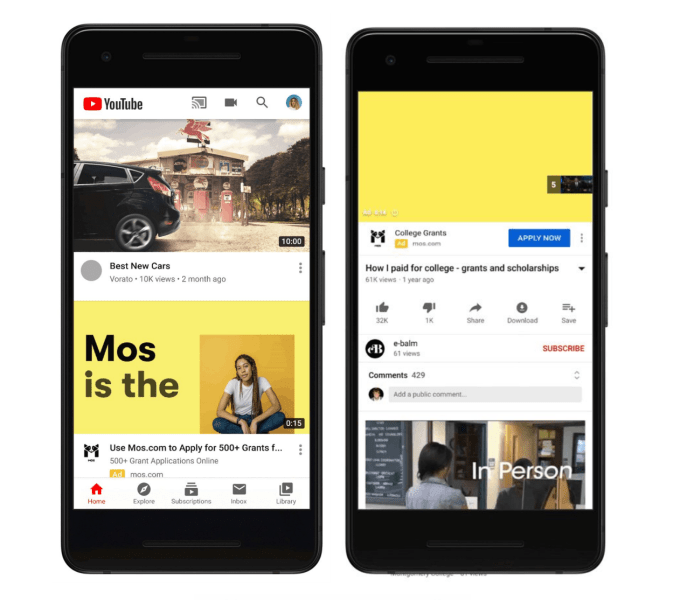
YouTube today announced a new direct response ad format that will make YouTube video ads more “shoppable” by adding browsable product images underneath the ad to drive traffic directly to brands’ product pages. The introduction of the format comes at a time when advertisers are trying to find new ways to capture consumers’ growing interest in e-commerce shopping, amid a pandemic that’s kept people from shopping brick-and-mortar physical stores for fear of infection.
YouTube, in particular, believes its platform can serve this shift in interest, given that today 70% of people claim they’ve bought a brand’s product because they saw it in a YouTube video.

To use the new shoppable format, brands will first need to sync their Google Merchant Center feed with their video ads. They can then visually expand an ad’s “call to action” button with the best-selling products it wants to feature in the ad in order to generate traffic that sends viewers directly to the product listing on the brand’s own website.
One early tester of the new format was Aerie, which wanted to advertise on YouTube to both boost consumers’ love for its brand and its apparel sales for its Spring 2020 campaign. The company ran targeted ads on YouTube and saw a 25% higher return on ad spend than the prior year as well as 9 time more conversions than with their traditional ad mix, YouTube says.
Related to this news, YouTube also announced “Video action campaigns” — a way to bring YouTube video ads that drive these sorts of calls-to-action to YouTube’s home feed, watch pages, and Google’s video partners, from within one campaign. The company says it will also include any future inventory that becomes available, like the What to Watch Next feed.

An early tester for this ad product was the startup Mos, which aims to help students find college scholarships. Over the past few months, Mos saw 30% more purchases for its service at the third of the cost, compared to its previous YouTube benchmarks, said YouTube.
Brands can also use the lead generation forms along with their video ad campaigns to capture more leads while also running their ads, as Jeep did with its Korea branch leading to a 13x increase in completed leads at an 84% lower cost per lead.
YouTube isn’t the only tech giant that’s focused more heavily serving the needs of brands — and particularly ecommerce brands — in recent months. Facebook and Instagram rolled out Shops in May, to turn business profiles into online storefronts where consumers can buy directly from brands without leaving Facebook’s or Instagram’s app. Snapchat also this month expanded its dynamic ads for e-commerce retailers worldwide, allowing brands to easily run automated product ads on Snapchat’s app by way of templates connected to product catalogs.
But YouTube’s ads are perhaps more similar to those shoppable video ads now appearing on streaming services like Hulu and NBCU’s Peacock where viewers can transact using their remote control. In YouTube’s case, however, viewers are just clicking and tapping their way through to the advertiser’s site.
Like many, YouTube believes businesses will continue to need solutions like these to find leads, boost their web traffic and drive more online sales, even when coronavirus-driven government restrictions lift and physical stores re-open.
Typically, announcements like this would have been made at YouTube’s NewFronts presentation, but as that event is now online-only due to the pandemic, YouTube has rolled out the news early.

